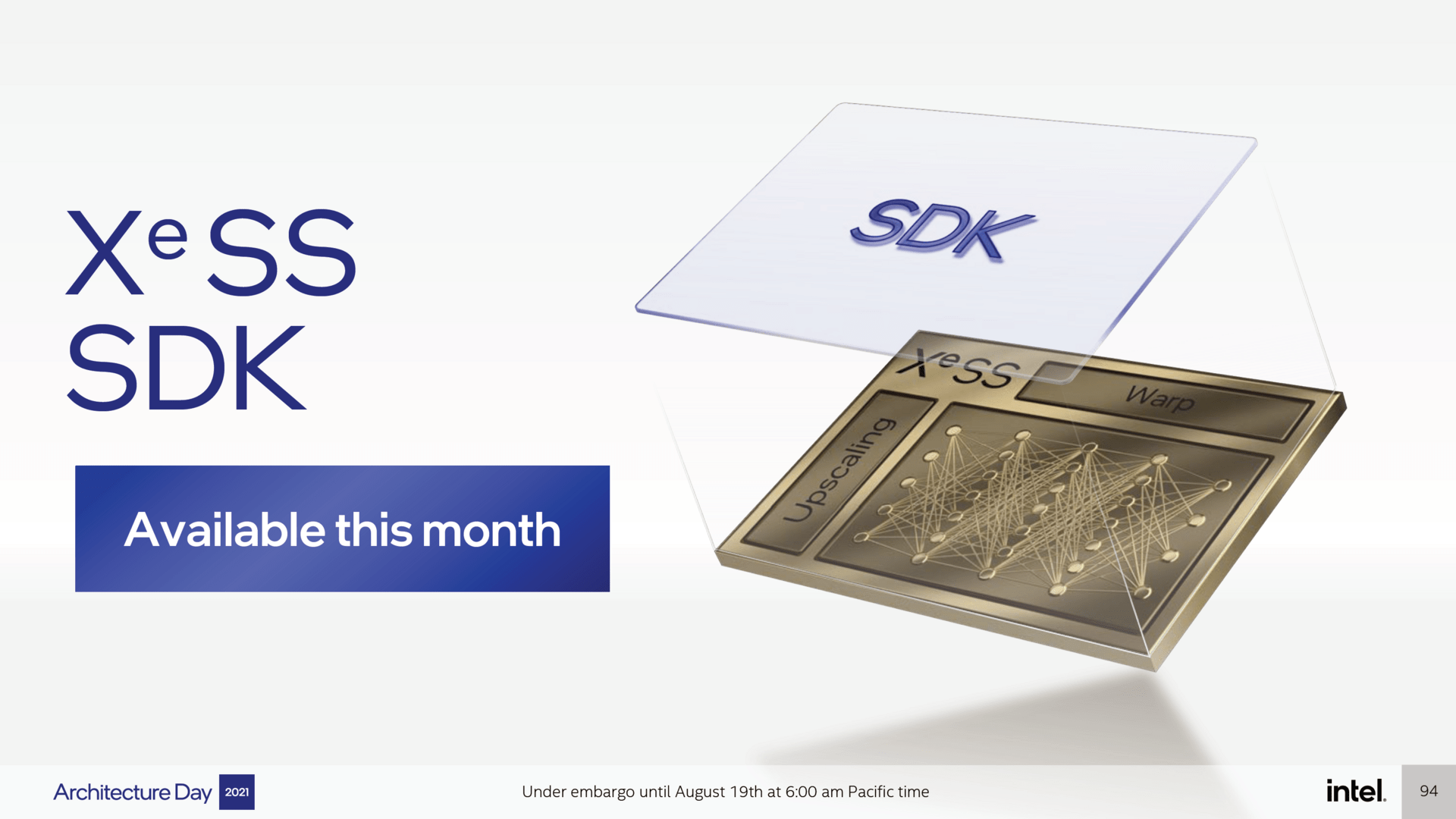Intel has announced a competitor to Nvidia DLSS for a sneak peek on the Alchemist GPU architecture for discrete gaming graphics cards of the Arc series. Xe Super Sampling, or Xe SS for short, relies on AI calculations, but unlike DLSS it will not only run on its own graphics cards, but also on GPUs from AMD and Nvidia.
Like Nvidia DLSS, the Xe SS is an intelligent upsampling process that enables rendering in a lower resolution in order to save computing power. The image is then upgraded using information from a neural network in order to achieve an image quality comparable to the original resolution. This is particularly useful in computationally intensive games with ray tracing.
Xe SS is very similar to Nvidia DLSS
The basic function of the Xe SS seems to be very similar to Nvidia DLSS 2.0 (test) and thus differs from AMD's current competitor technology FSR 1.0 (test). With Xe SS, too, the image is rendered in a lower resolution and then an attempt is made to restore the original quality by comparing previous frames and combining these findings with the image rendered in lower resolution. This step using the information from the neural network is basically exactly what Nvidia does with DLSS 2.0.
With Xe SS, the step takes place after the grid and light calculations, but before the post processing, which apparently still takes place with the native resolution. In addition, the neighboring pixels of each frame are individually analyzed and compared in order to achieve the best possible visual result.
Like DLSS, Xe SS has a temporal component
Xe SS therefore has a temporal component, which should enable Intel's technology, like DLSS, to restore picture elements not fully computed in low resolution with the information of old frames. In addition, the high level of image stabilization usually observed by DLSS is to be expected, but also temporal image errors that the neural network must try to prevent as much as possible.
AMD's FSR, on the other hand, works without a neural network and temporal components, which generates fewer graphics errors, but is dependent on the anti-aliasing integrated in the game in terms of image reconstruction and stability. DLSS and then probably also Xe SS replace the anti-aliasing completely instead.
Xe SS via matrix engines on GPUs from Intel, Nvidia and AMD
Up to this point, Xe SS is similar to Nvidia's DLSS, but in another point the technology seems to follow AMD's FSR much more: Like FSR, Xe SS should not only work on Intel GPUs. On Intel's GPUs, the neural network is accelerated by means of the matrix engines and thus the equivalent of Nvidia's tensor cores, which should lead to optimal performance and image quality, but also on Nvidia's GPUs and even the GPUs from AMD without AI functions.
Xe SS is accelerated there via DP4a instructions and thus ultimately accelerated via the normal FP32 shader ALUs with an accuracy of INT8. According to Intel, this should be slower than via the matrix engines, although the manufacturer only speaks of a small difference. How fast Xe SS will run on non-Intel Arc GPUs depends on how fast they can handle DP4a. Intel's Arc should achieve performance increases of “up to 2 ×”, other GPUs accordingly less.
 The performance of Xe SS (Image: Intel)
The performance of Xe SS (Image: Intel) Nvidia's Turing and Ampere architecture can accelerate INT8 with DP4a via the tensor cores, but it is unclear whether this will happen automatically and without code adjustment with maximum performance – ComputerBase is currently not assuming this. From the Pascal generation, DP4a is also available accelerated on the normal FP32-ALUs. AMD's RDNA 2 can accelerate INT8 with Rapid Packed Math via the FP32-ALUs, but it is not yet certain whether this will also work with DP4a instructions. The editors are currently trying to get this information from AMD, but are pretty sure that the new Radeons (but only RDNA 2) can handle it. And even if DP4a cannot be accelerated on a GPU, it should always be possible to run it without speed gain on the FP32-ALUs. It is then questionable whether this is still worthwhile in terms of performance.
Xe Super Sampling becomes open source
More details about Xe SS are not yet available. However, Intel says that the graphic quality should come very close to native Ultra HD when rendering in Full HD. To what extent there will be different levels of quality is still unclear. In any case, Intel has big plans: The technology should make it into numerous engines and, last but not least, be easy to integrate. There should already be an integration in Unreal Engine 5, and Xe SS will also be completely open source at a later date.
In the course of this month, a first SDK is also to be released for Intel's matrix engines, with which developers can incorporate the technology into their own game. A variant for the DP4a instructions will follow later this year.
 Intel Xe SS as SDK and Open Source (Image: Intel)
Intel Xe SS as SDK and Open Source (Image: Intel) ComputerBase has the information in advance at an event in Berlin as part of Intel's Architecture Day 2021 NDA received. The manufacturer did not exert any influence on the reporting, and there was no obligation to publish. The only requirement was the earliest possible release date.